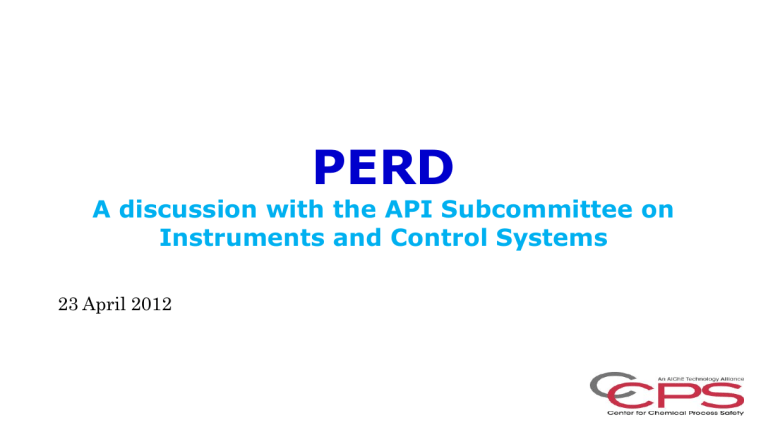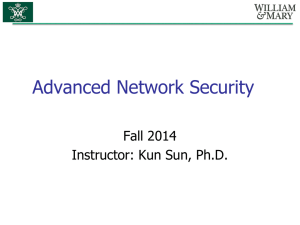CCPS PERD Reliability API Presentation_r3

PERD
A discussion with the API Subcommittee on
Instruments and Control Systems
23 April 2012
Your Presenters
Gene Meyer
Dow Chemical, 28 years
Reliability Engineering for the last 12 years.
Hal Thomas (on the phone)
Exida (formerly Air Products)
Process Safety
Original chair of PERD
2
Alignment
AICHE
CCPS, Center for Chemical Process Safety
PERD, Process Equipment Reliability Database
• Participants
» Members and Users
A subscription-based project with CCPS.
3
Agenda
•
Introduction
•
Alignment
•
Organization
•
Goal
•
The solution
•
Details
•
Results
•
Discussion
4
Reliability Situation
Industry-specific reliability data is not available.
Quality company data is scarce.
Performance-based regulations enacted.
CPI and HPI capital intensity forces greater asset management (i.e. higher process reliability)
5
Process Safety Situation
Performance-based regulations enacted.
Lack of quality data reduces confidence & jeopardizes industry credibility with respect to quantitative analysis results
Performance-based processes require quality management systems that are auditable and defensible
Quality Assurance requires data to validate performance assumptions
6
Current Reliability Modeling Situation
7
The Vision
Readily available Maintenance and Reliability Data that:
Is generated from equipment like yours,
Is automatically loaded into a database,
Represents industry experience,
Is validated for accuracy,
Is statistically evaluated by documented methods,
Is benchmarked versus your industry
Is available for your use in:
Simulation
Process validation
Process design and troubleshooting
Reliability Growth
Quantitative Risk Assessment
8
The Solution
PERD
Process Equipment Reliability Database
A database that works with your computerized maintenance management system to upload equipment performance data, organize, validate, calculate, benchmark and make available for use with clear statistical guidance.
The database that uses company and industry equipment performance data evaluated against industry standards.
9
PERD is:
A member-led project developed by CCPS to provide equipment reliability data with the following mission :
The PERD Mission
Operation of an Equipment Reliability Database, Making
Available High Quality, Valid, and Useful Data to the HPI and CPI Enabling Analyses to Support Availability,
Reliability, and Equipment Design Improvements,
Maintenance Strategies, and Life Cycle Cost Determination
PERD Provides:
Practical approach and Consistent work processes for data collection
Sound theoretical foundation based on engineering fundamentals
Efficient software tools for data submission
S/W dedicated for use by participating companies
Quality assurance for data analysis
Identification and analysis of outliers
Defensible and auditable results
11
PERD History
During development of CCPS Chemical Process Quantitative Risk
Analysis book, committee concluded a separate guideline book was needed to address data
1989 - The result was Guidelines for Process Equipment Reliability
Data with Data Tables
Following publication, Hal Thomas and Tom Carmody attended an
OREDA meeting and concluded data mining was too expensive, but data harvesting if implemented properly was sustainable, hence the
PERD initiative was born.
1998 – Guidelines for Improving Plant Reliability Through Data
Collection and Analysis published establishing the basic foundational approach
Today – Work processes established and documented, rolling out
2 nd generation PERD software, continuing to develop equipment taxonomies & analyze equipment data
12
Fundamental Concepts
Develop & document equipment boundary diagram
Perform rigorous “Functional Analysis” to determine and document all of the fundamental failure modes that represent complete or degraded failures as well as documenting incipient conditions for an equipment type
Reference paper by Rausand and Oin in their critique of OREDA database
13
Fundamental Concepts Continued
Engineer information systems to
Support data acquisition using a experimental design mentality, facilitating immediate data analysis
Input only facts, i.e. do not require interpretation on part of mechanic or technician
• Make use of standard pick lists to extent possible
Create event input forms that allow inference of failure modes by asking the question, ‘What data is it that would allow us to conclude a particular failure mode has occurred.
14
Fundamental Concepts Continued
Leverage existing information systems that are going to exist anyway, improving data quality with no increase in cost
Design equipment design spec data fields to be PERD compatible
Design process demand, inspection and test record data fields to be PERD compatible
15
Fundamental Concepts - The Data Farm
Quality info for use in reliability analysis, maintenance strategies, risk analysis, etc.
Events occur on a continuous basis
Electronically extract validated data
Periodic batch transfer of data
PERD Database
163Feb00_Ins urance
16
An Integrated Approach
CCPS PERD
Industry Offline Reliability
Analysis Database
Corporate PERD
In-Tools
Maintenance Module
(i.e. SAP, Maximo, etc.)
Population Data
Process Specs
Facility PERD
Operating Group
Information System(s)
Maintenance
Activities
Process Events
Process Specs
Design Specs
Purchase Order
Installation
Commissioning
Plant Operation
Inventory Data
ID Number
T ag Number
Event Data
M aintenance
Inspections
Proof T esting
Incidents
Etc.
CCPS Industry
Database
Company 1
Database
The Harvest
Company 2
Database
Company n
Database
Plant 1
Data
Plant 2
Data
Plant n
Data
Inventory Data
Event Data
Inventory Data
Event Data
Initiative Focus
Sound theoretical foundation
Practical application to plant and equipment, including software tools
Fundamentally sound engineering information available to companies to “Engineer” their information management systems
Industry database built upon the platform above
Capitalize on opportunities
Company databases adapt to the platform above
19
Fundamental Taxonomy Relationships
Inventory Record
Application Data Fields
T ag Number
Device Data Fields
Equip ID
- Equip Descriptors
Operating
Conditions
Operating
Mode
Events
Equipment Function(s)
Failure M ode(s)
Failure
M echanism(s)
Failure
Cause(s)
Relationship Legend
M any to M any
One to M any
M any to One
One to One
The same is true for
Reliability & simulation
Built Upon a Sound Technical Foundation
PERD Has Adopted a Data Tier Structure That:
Eliminates Data Intimidation
Allows more rapid expansion of partial Equipment taxonomies and associated software development
Basic Tier Concept
Tier 1 – Whatever minimal data might exist – Gets people started; generates a useful event record. Pass/fail
Tier 2 – Begins to provide event specifics; population filtering and failure classification
Tier 3 – Top of the “PERD ladder of success”; failure modes
22
23
Equipment Groups & Systems
Equipment
Groups
Equipment
Systems
Electrical Fixed Equipment
Circuit Breaker
Contactors
Motor
Relays
Transformer
Cylinder
Heat Exchanger
Piping Circuit
Pressure Vessel
Atm Storage Vessels
Instrumentation
Analyzer
Annunciator
Fire & Gas
Detection
Loop
Sensing Element
Switch
Transmitter
Signal Conditioning
Unit
Control Logic Unit
Pressure Relieving
Devices
Reclosable pressure
Relief Devices
Non-reclosable
Pressure Relief
Devices
Hydraulic
Accumulator
Liquid Seal
Open Vent
Rotating
Machinery
Valves
Agitator
Compressor
Pump
Turbine
Check Valve
Hand Valve
Self-Actuated
Solenoid Valve
Remote Actuated
Expandable
Inventory Data Tier Concept
Tier 1
Location Address (e.g. Plant, tag, etc.)
Equipment Group (e.g. Instrumentation)
Equipment System (e.g. Transmitter)
Comments *Equip Group
*Equip System
*Tag Number
*Equip ID
PL_Equip_Grp
PL_Equip_Sys
Equipment
Type & Subtype
Example
Equipment
Group
Pressure Relieving
Devices
Equipment System Equipment Type
Equipment Subtype
Reclosable pressure relief devices
Pressure Relief Valve
(Spring Loaded)
Non-reclosable pressure relief devices
Hydraulic accumulator
Liquid seal
Open vent
Pilot Operated Relief
Valve
Conservation Vent
Self-Closing Manhole
Cover
Rupture Disk
Explosion Vent
Blow-off Man-way
Rupture Pin
Buckling Pin
Weak Gauge Hatch
Fusible plug
Weak shell to roof seam
PL_REL_SubType
Conventional
Balanced Bellows
Balanced Bellows With
Auxiliary Balanced Piston
25
Inventory Data Tier Concept
Tier 2
All tier 1 data plus following data user chooses to enter
Equipment Type (e.g. Differential
Pressure)
Equipment Subtype (e.g. Level)
Manufacturer
Model Number
Output Signal or Set Point (As applicable to equipment)
Transmitter Type
Transmitter
Subtype
Manufacturer
Model Number
Output Signal
Set Point
PL_Equip_Type
PL_Equip_SubType
PL_Mfr_Equip
PL_Equip_Sig_Out
PL_Equip_Set_Point
Whichever field is applicable
Inventory Data Tier Concept
Tier 3
All tier 1 data
Equipment type
Equipment subtype
Plus additional tier 2 and / or 3 data user chooses to enter
Possible to achieve level of a complete equipment specification
Event Data Tier Concept
All Events require
• Linkage to tracked equipment
• Event date (and time if applicable)
Tier 1
• Data showing a failure has occurred
Tier 2
• Data sufficient to infer whether failure was “Dangerous” or
“Safe”
Tier 3
• Data sufficient to infer true failure modes
User decides what event data to track!! Event data tracked determines what level of inference is achievable.
Relief Valve Proof Test Example
29
Getting Started
Upon Joining as a Full Participant
PERD provides the software & initial help to companies loading the software onto their company server
PERD provides initial help and guidance allowing you to contribute whatever data you have, enabling companies to quickly get involved and begin accruing benefits
Company data contribution means access to aggregated anonymous industry data and a path to continuous improvement
30
Helping Hand Work Process – Getting Started
Ad Hoc Data Acquisition & Analysis
Existing CMMS or other Info Mgmt
System
Company downloads data
Company submits data to
CCPS PERD
PERD
Performs
Data Map
PERD translates data & populates PERD compatible files
PERD
Guidance
Helping Hand Work Process
PERD Imports
Data & Manages
Dataset
PERD Aggregates
Data
(Multiple Data
Subscribers)
PERD Anonymizes
Data
Data Analysis
31
Immediate Benefits
Access to fundamental technical information that documents specific data user needs to:
Filter inventory data for populations of interest
Infer failure modes of interest
Access to work process knowledge needed to achieve company goals
Facilitates moving to data farming (low cost) work process rather than data mining (high cost) activity
Enables maximization of benefits from enterprise systems (eg SAP,
Maximo, Matrikon, Meridian, etc.)
Provides pre-engineered solutions that can be implemented cost effectively
Best available info transfer between engineering and programmers
32
On-Going Work Process
On Going Data Acquisition & Analysis
Existing CMMS or other Info Mgmt
System
Company downloads data in compatible format
Company
Documents Quality
Plan
Quality Process
Company submit data to CCPS PERD per quality plan
PERD import data into industry database
PERD Aggregates data from
(Multiple Data
Subscribers)
PERD makes data anonymous
33
Long Term Benefits
Data Harvesting per Defined Quality Plans Provide:
Operating company database capable of achieving proven in use data for safety and reliability analysis
Data Contribution to PERD Facilitates
Operation of industry database
Industry benchmarking
Statistical analysis by true experts due to best data available to support their research
Data available for improved reliability and risk analysis
On going continuous improvement via reliability growth
34
Why Join PERD?
PERD enables user companies to leverage existing IT and
MI systems to collect and submit data resulting in:
Improved Reliability
Industry benchmarking
Identification of “low hanging fruit” for immediate impact
Minimization of unforeseen losses
Increased Effectiveness for
Information Systems Technology
Reliability & Quantitative Risk Assessments
Regulatory Compliance
For a small financial investment and minimal data.
35
You would join…
Full Participants
o Air Products o Chevron o DNV o Dow Chemical o DuPont o FM Global
Subscribers & Volunteers
o
Exida
o
Rosemount
o
Savannah River Site
o
Sis-Tech
o
TMC
36
Getting Started.
Join as a Full Participant
Benefits of Full Participant Status:
PERD provides the software & initial help to companies loading the software onto their company server
PERD provides initial help and guidance allowing you to contribute whatever data you have, enabling companies to quickly get involved and begin accruing benefits
Company data contribution means access to aggregated anonymous industry data and a path to continuous improvement
Networking with industry experts involved with the PERD project.
37
In Summary
PERD provides you a roadmap to improved performance whereby you can
Improve Information Systems Effectiveness
Create Value
Minimize unforeseen losses
Improve Regulatory Compliance Effectiveness
Enroll Now!!
38
For More Information Contact
Dave Belonger – CCPS PERD Staff Consultant
609-654-4914
dbelonger@verizon.net
Gene Meyer – Chairperson
Dow Chemical
(989) 638-4064
grmeyer@dow.com
Hal Thomas – Technical Consultant
exida
610-481-9681
thomashw@exida.com
39
40






